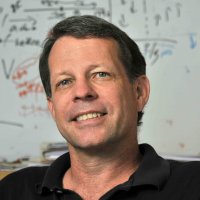

|
Professor of Oceanography
Current Research Projects:
Selected Publications: E. A. Ottesen, C.R. Young, S. M. Gifford, J. M. Eppley, R. Marin III, S. C. Schuster, C.A. Scholin and E. F. DeLong. 2014. Multispecies diel transcriptional oscillations in open ocean heterotrophic bacterial assemblages. Science 345: 207-212. Sara A. Lincoln, B. Wai, J. M. Eppley, M. J. Church, R. E. Summons, E.F. DeLong. 2014. Planktonic Euryarchaeota are a significant source of archaeal tetraether lipids in the ocean. Proc, Natl. Acad. Sci. USA, 111:9858-63. Ottesen E.A., Young C.R., Eppley J.M., Ryan J.P., Chavez F.P., Scholin C.A., DeLong E.F. 2013. Pattern and synchrony of gene expression among sympatric marine microbial populations. Proc Natl Acad Sci U.S.A. 110:E488-97 J. A. Bryant, F. J. Stewart, J. M. Eppley and E. F. Delong. 2012. Microbial community phylogenetic and trait diversity declines steeply with depth in a marine oxygen minimum zone. Ecology 93:1659-73. F. J. Stewart, O. Ulloa and E. F. DeLong. 2012. Microbial metatranscriptomics in a permanent marine oxygen minimum zone. Environ. Microbiol. 14:23-40. McCarren, J., Becker, J., Repeta, D., Shi, Y., C.R. Young, Malmstrom, R. Chisholm P., and E. F. DeLong. 2010. Microbial community transcriptomes reveal microbes and metabolic pathways associated with dissolved organic matter turnover in the sea, Proc, Natl. Acad. Sci. USA 107:16420-16427. Shi, Y., Tyson, G. W., and E. F. DeLong. 2009. Metatranscriptomics reveals unique microbial small RNAs in the oceanís water column. Nature 459: 266-269. Falkowski, P. D., Fenchel, T. and E.F. DeLong. 2008. The microbial engines that drive biogeochemical cycles. Science, 320:1034-1038. DeLong, E. F., Preston, C. M.., Martinez, A., Mincer, T., Frigaard, N.U., Rich, V., Hallam, S. J., Sullivan, M., Edwards, R., Beltran, R.B., Chisholm, S. W., and D. M. Karl 2006. Community genomics among stratified microbial assemblages in the oceanís interior. Science 311: 496-503. Frigaard, N.U, Martinez, C., Mincer, T., E. F. DeLong. 2006. Proteorhodopsin lateral gene transfer between marine planktonic Bacteria and Archaea. Nature 439:847-850. DeLong. E. F. and D. M. Karl. 2005. Genomic perspectives in microbial oceanography. Nature 437: 336-342. Hallam, S. J., Putnam, N.. Preston, C.M., Detter, J.C., Richardson, P. M., Rokhsar, D., and E. F. DeLong. 2004. Reverse Methanogenesis: Testing the Hypothesis with Environmental Genomics, Science, 305: 1457-1462. Béjà O., Suzuki, M. T., Heidelberg, J.F., Nelson, W.C., Preston, C.M., Hamada T., Eisen, J.A., Fraser, C., and E. F. DeLong. 2002. Unexpected diversity among marine aerobic anoxygenic phototrophs. Nature 415:630-633. Orphan, V. J., C. House, K. U. Hinrichs, K. McKeegan, and E.F. DeLong. 2001. Methane-consuming archaea revealed by directly coupled isotopic and phylogeneticanalysis. Science 293:484 487. Béjà, O., L. Aravind, E. V. Koonin, M. T. Suzuki, A. Hadd, L. P. Nguyen, S. B. Jovanovich, C. Gates, R. A. Feldman, J. L. Spudich, E. N. Spudich, and E. F. DeLong. 2000. Bacterial rhodopsin: evidence for a new type of phototrophy in the sea. Science 289: 1902-1906. K.-U. Hinrichs, J. M. Hayes, S. P. Sylva, P. G. Brewer, and E. F. DeLong. 1999. Methane consuming archaea: Molecular-isotopic and phylogenetic evidence, Nature 398:802-805. DeLong, E. F., K. Y. Wu, B. B. Prezelin and R. V. M. Jovine. 1994. High abundance of Archaea in Antarctic marine picoplankton. Nature 371: 695-697. DeLong, E. F., D. G. Franks and A. L. Alldredge. 1993. Phylogenetic diversity of aggregate-attached versus free-living marine bacterial assemblages. Limnol. Oceanog. 38:924-934. DeLong, E. F. 1992. Archaea in coastal marine environments, Proc. Natl. Acad. Sci. USA, 89: 5685-5689.
|
||||


